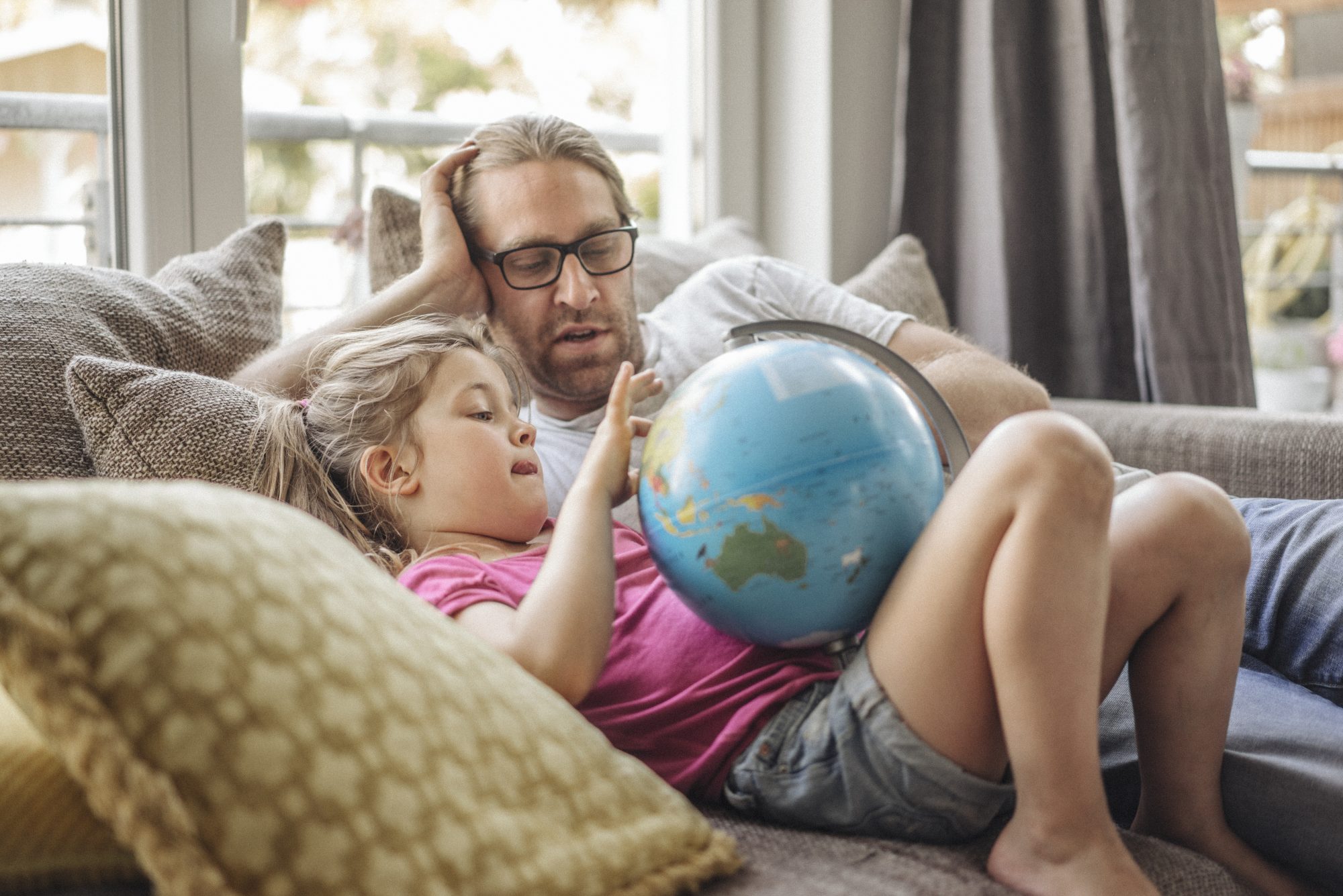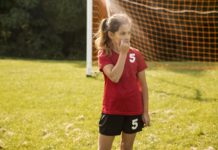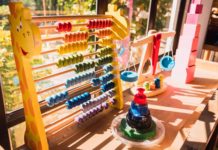While adults haven't exactly done a bang-up job of protecting the planet for future generations (see headlines regarding our rapidly warming climate as exhibit number one) it is still possible to redeem ourselves somewhat by changing our daily habits right now to be more eco-friendly and climate conscious.
It's also critical that, as parents, we teach our kids to follow suit, instilling in them the importance of living a life that's respectful of mother earth—one that includes making daily choices and decisions that are sustainable and considerate of nature, biodiversity, and the overall health of our communities and planet. Future generations, after all, will be the ones to inherit all of the challenges now materializing around the globe.
Many of the lessons that can be taught about living sustainably and thoughtfully are doubly important because they also involve educating our children about personal finances, including spending wisely, being judicious about consumption, and consistently following behaviors that are cost-conscious and save money.
Related: Teaching Kids About Money: An Age-by-Age Guide
Need a little inspiration to get started on these critical lessons with your children? To help with that effort, we've rounded up 14 kid-friendly ways to marry education about money and sustainable living.
Shop for secondhand clothing.
Learning to consume less is a gigantic lesson for all of us because the earth obviously has finite resources. Our consumer culture must change for the good of the planet. It's a lesson that can be taught to the youngest of consumers by taking them to stores where secondhand items are available, rather than constantly heading off to Target or Walmart for something new.
"We often buy things for our kids secondhand, either off of Facebook Marketplace, or at thrift shops," Curt Storring, creator of the parenting platform Dad.Work, tells Parents. "Since they grow out of clothing so quickly, it makes sense for us financially, but it also allows us to have conversations with them about how we can buy perfectly good, almost-new clothing, instead of contributing to the environmentally-detrimental fast fashion culture of today."
The fashion industry is a major greenhouse gas and waste contributor. What most people don't understand is that 95 percent of textiles have the ability to be repurposed, but currently, we are only recycling 15 percent, says Ksenia Yudina, CFA, founder and CEO of UNest, a college saving app.
"Using hand-me-downs whenever possible is a great way to cut down on this type of waste, and save money at the same time. Particularly when children are young, they are constantly outgrowing their clothing, so it's economical to reuse old clothes from friends, family, or even a secondhand store," says Yudina.
Storring also makes it a point to let his children know that the second-hand clothing being purchased will make its way back to the thrift store once it no longer fits. A single article of clothing could go through three or four cycles of ownership, says Storring, rather than using resources to create more and more new clothing that might end up in landfills when it is no longer needed.
The beauty of these types of lessons is that children can apply them to their own shopping behavior now and as they grow older, saving money and being eco-conscious all along their life journey.
Pack zero-waste school lunches.
School lunches can be a giant dilemma for parents when it comes to packing meals that are cost-effective and appealing to kids, without being environmental disasters (think: lots of plastic waste from single-use baggies and water bottles, not to mention food waste.)
Dr. Erica Dodds, COO of the Foundation for Climate Restoration, a sustainability, climate change, and eco-anxiety expert, suggests trying to create zero-waste lunches and getting your kids engaged in the process — a practice that can save you money right now, and teach growing minds how to do so when they lead a household.
"Instead of kids eating at the school cafeteria, don't let your veggies or other food go to waste—whip up something new and surprisingly delicious out of the food that's about to go bad, and help stop the massive global food waste," explains Dodds.
While you're at it, begin teaching children about the importance of incorporating reusable and refillable food containers or bento boxes into lunch preparations— instead of spending money repeatedly on plastic baggies and lunch bags, which go to waste. Take the time to explain to your kids why this step makes a difference to the planet and the household budget.
"Whether we're thinking of juice boxes, Lunchables, or pre-packaged foods, I teach children the importance of bringing refillable containers over pre-packaged goods," Eva Petruzziello, creator of the sustainable living website Simple n' Delight and an eco-schools teacher, tells Parents.
"In my classroom, we talk about how we can save the environment by reducing the need for packaged goods. I teach kids that this will help by reducing the energy needed for transport to landfills, by reducing waste in our landfills, and by reducing the need for more plastics from fossil fuels and non-renewable resources," continues Petruzziello. "Children are also taught that this simple practice can save a household hundreds of dollars each year."

Create a comparison chart.
While we're on the topic of single-use plastics (which are an environmental nightmare) here's another lesson to consider: Create a comparison chart where you track the cost difference between buying single-use bottled water and using a refillable water bottle.
"Parents can very affordably buy a reusable water bottle and then spend a week tracking how often you fill that bottle. Compare that to the cost of purchasing plastic bottled water at a local store each time you refill the reusable bottle," says Aerik Radley, director of education marketing at SECNY Federal Credit Union and an adjunct professor at Cazenovia College.
By the end of the week, your comparison chart should be a great visual for your child, allowing them to not only see how they saved money, but also how much they reduced waste for the family.
Be more selective when choosing a bank.
This lesson might be slightly more appropriate for older children, perhaps teens, but it is nevertheless an important conversation to have. Banks, through their funding of fossil fuel projects (which are paid for with the money you and I deposit into our checking and savings accounts), are among the world's leading facilitators of climate change.
This reality has inspired the creation of a cottage industry of new banks that are using money to exclusively fund clean energy projects that combat climate change. Ando and Climate First Bank are just a few of the leading options in this growing space. Take the time to explain the consequences of banking decisions to your children.
"Some banks and financial institutions are taking a more active role than others in reorienting their investment and divestment strategies for climate change. Talk to your kids about green banking. Explain to them how bank use money, by investing it, and encourage your children to look for banks that are committed to meaningful corporate social responsibility," Donny Gamble, founder of Retirement Investments, tells Parents.
Buy secondhand electronics.
Every year, millions of phones, laptops, cameras, printers, routers, modems, and other electronic devices are discarded, which is bad news for the environment. Let your kids know that e-waste is a major environmental problem, and that the manufacturing of cheap electronics requires massive amounts of mining and extraction, says Gamble.
"Encourage kids to spend their money on a used device, thus keeping it out of the landfill where it does its damage to the environment," says Gamble.
Related: 10 Money Lessons to Teach Your Kids Before They Turn 10
Purchasing secondhand electronics will not only save money; it also avoids the unnecessary introduction of a new device into circulation. It's a lesson your children can carry with them throughout their lives.
Teach kids about energy consumption.
Not only is the cost of energy skyrocketing thanks to inflation, but it's often generated with fossil fuels, making this a prime area where you can teach children about how to alter their daily habits to protect the planet and save money in the process.
"Show them how much energy an appliance uses with a simple meter gauge and explain how important it is to turn off lights and electronics when leaving the room," says Mo Mulla, founder of the website Parental Questions.
Choose quality over quantity.
Teaching children about selecting quality over quantity is a lesson that can be applied to everything from clothing to furniture to accessories and home appliances. And you can begin teaching this lesson by modeling the behavior yourself and explaining your purchase decisions to your children.
"The best thing you can do is purchase quality items that can be replaced less frequently. Although you may spend more upfront, you'll actually end up saving money in the long run because it won't have to be replaced so soon," Guadalupe Sanchez, founder of the website Budgeting in Blue, tells Parents.
Dine out sparingly.
Eating out produces a lot of food and material waste, says Sanchez. It also costs far more than eating at home. Here, too, you can model eco-friendly and financially savvy behavior for your children and explain your choices and the reasoning behind them.
"When you eat out you get disposable silverware, plates, and cups. These items are not recycled or reused," says Sanchez. "They end up in landfills and produce harmful gases. Eating out less will save you thousands each year, and also save the earth from less waste."
When you do eat out, remember to bring reusable food containers with you from home for any leftovers, rather than use the restaurant's plastic or styrofoam containers, which are not eco-friendly.
Only buy the groceries you really need.
In case we haven't already made it abundantly clear: The human race wastes a lot of food (and money in the process). Another way to tackle this challenge and also save money is by only purchasing the groceries you really need. And when you're at the grocery store doing your shopping, explain buying decisions to your children—particularly when they try to sneak extra items into the shopping cart.
"Unfortunately, about 30 to 40 percent of our food supply is wasted every year. This means that the natural resources that were used to produce the food didn't have to be used at all," says Sanchez. "Be mindful when you go grocery shopping. The best thing you can do is meal-plan and only purchase what you need. Don't buy food and then plan to cook something, as this approach always produces food waste."
Consume less meat.
Meat production is extremely harmful to the environment. A scientific assessment recently reported in The Washington Post attributed 23 percent of total global warming to the livestock sector and its operations, which includes using energy and fertilizer, causing deforestation, and releasing methane. The meat industry is doing its best to fight climate action and widespread adoption of more eco-friendly, plant based diets, but encouraging young eaters to eat less meat (you don't have to eliminate it entirely from your diet), can be a huge step forward for the planet, your health, and your household finances.
Related: How to Get Kids to Eat Vegetables and Healthy Foods
"Most people don't know this because they don't teach us these things in school, but if people committed to eating meat only twice a week, we would significantly reduce our CO2 emissions," says Sanchez. "This would help the environment and your wallet, as meat can be expensive."
Focus on experiences over things.
There's no hiding or denying the fact that we live in a materialistic society where purchasing one thing after another after another…is viewed as perfectly acceptable. Unfortunately, most of the things we purchase end up in the garage or in the back of our closets, says Sanchez.
"Focus on experiences over things. Instead of spending money on clothes, electronics, and one-time-use items, spend that money on vacations, museums, movie theaters," advises Sanchez. "At the end of the year, you'll realize that you saved a lot of money by simply buying fewer things."
What parent can't get behind that lesson for their children? And as an added bonus, it's a lesson that involves spending more quality time with your kids.
Start a garden.
During the pandemic, people everywhere began growing their own vegetables, and that was a great development; after all, homegrown produce saves money on grocery shopping and cuts down on the waste associated with the single-use plastic packaging of store-bought goods. If you haven't yet jumped on the home gardening bandwagon, now may be a good time to do so in order to teach your children the valuable financial and sustainable lessons that come with making this lifestyle change.
Related: The Family Guide to Gardening with Kids
"The three generators of waste, according to the EPA, are economic activity, consumption, and population growth. Gardens can curb some of the waste within the US," Jasmine Paul, a certified financial education instructor, Department of Defense budget analyst, and author of the award-winning children's book, A Boy, a Budget, and a Dream, tells Parents. "Growing your veggies, fruits, and herbs will cut down on the grocery store bill. Gardens also promote a sense of ownership, responsibility, and fiscal stewardship."
Teach children to pick the book, not the toy.
If you're a parent, you know exactly which restaurant we're talking about here. Yes, McDonald's and those Happy Meals.
"Teach children that a treat meal at McDonald's does not mean adding additional plastic waste to our landfills," says. Petruzziello. "The toys are attractive for about five minutes until they lose their shine.
And here's the money element of this particular life lesson: The books that come with Happy Meals can be read and re-read, then donated to someone else and used again, saving other families money on the purchase of a book.
Mending, sewing, and repairing are essential.
It should probably come as no surprise that Petruzziello, an eco-educator, sews the holes in pants whenever possible, rather than simply running out and purchasing a new pair. It's a lesson you can model for your children.
"In our classroom and household, we teach children to repair things whenever possible. We teach them that this practice will eliminate the need to buy new things, and help the school and home save money," says Petruzziello.
Walk, bike, and carpool.
You might also begin educating your children about making the shift to walking or biking whenever possible, instead of driving, and explain how this decision reduces reliance on cars powered by harmful fossil fuels (another area where costs are currently skyrocketing thanks to inflation). Walking and biking more regularly has so many perks, including financial, environmental, and health benefits.
"Children can understand from a very young age that this will not only save money on gas but will also help the planet from contributing to carbon emission," says Petruzziello. "If you must drive, show children how carpooling can reduce the cars on the road and help the family to save money."
Teach children how to care for their things.
This is a very important lesson and may even be more important than all the others on this list, says Petruzziello.
"Teaching children to care for their things and not lose them is a very important lesson both environmentally and monetarily. Children need to understand that when they throw their things on the pavement, or forget them somewhere, this costs the family more money to replace the items, and costs the earth too," Petruzziello explains. "Children often take for granted their jackets, bottles, and lunch bags. Teaching them to care for these items is an excellent lesson that they can use for the rest of their lives."
The time to start is now.
It is never too early to begin teaching children the lessons on this list, particularly those related to the importance of only buying what we need versus everything we want. Young children are naturally curious and eager to learn as much about the world as they can.
"Instead of simply saying 'no' and cringing at the thought of the giant plastic play set they keep asking for, talk to and involve children in your decision-making. They just want to know why," says Roxanne Nowak, a marriage and family therapist with Heart-Full Minds Counseling. "Problem-solve other options together. You can explain the importance of less stuff and the impact consumerism has on the environment through the same language you use to teach them about why we shut off the faucet when brushing our teeth."
Educating kids about the importance of using daily actions to protect nature, biodiversity, our oceans, and wild spaces helps foster a deeper connection with and love for the earth. Teach them to question whether they want to blindly do what everyone else does, and encourage them to carve their own path—one that's more thoughtful about protecting the planet.
The good news? Not all of these lessons have to be directly and obviously linked to money.
"You can then visit beaches, lakes, and forest trails to reinforce that learning and love for nature," says Nowak. "Help your kids understand that when we focus less on stuff, we have more time to enjoy our planet with each other."





